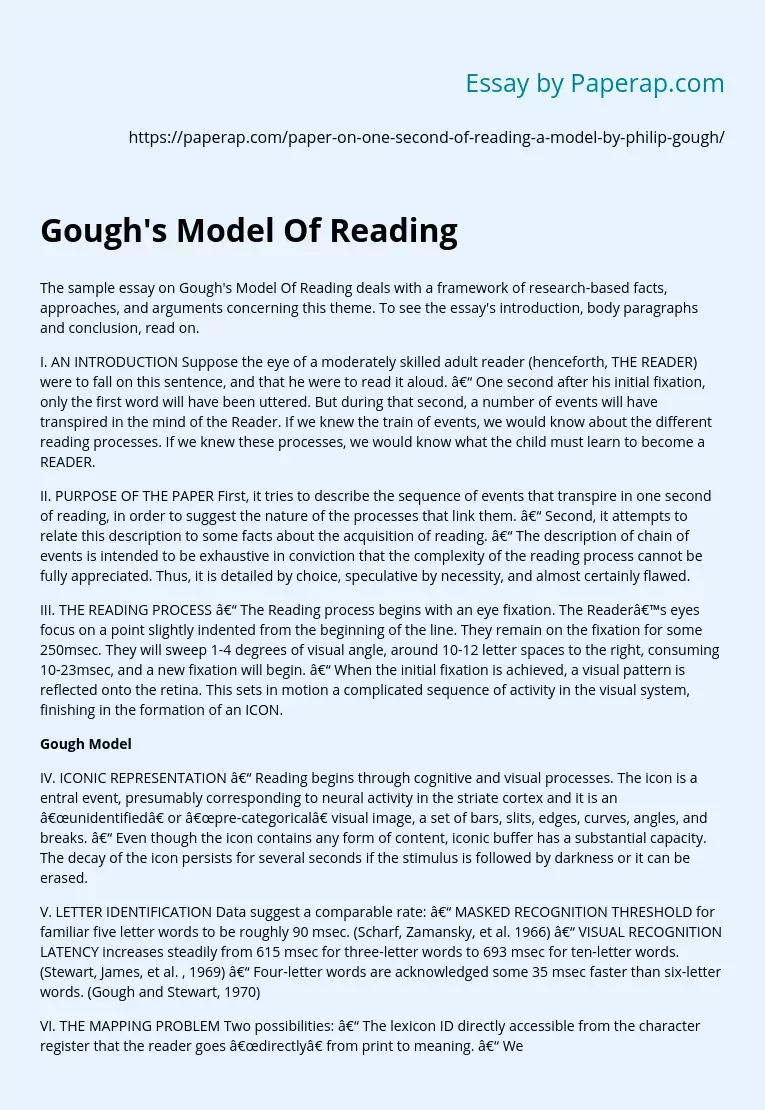The sample essay on Gough’s Model Of Reading deals with a framework of research-based facts, approaches, and arguments concerning this theme. To see the essay’s introduction, body paragraphs and conclusion, read on.
Suppose the eye of a moderately skilled adult reader (henceforth, THE READER) were to fall on this sentence, and that he were to read it aloud. – One second after his initial fixation, only the first word will have been uttered. But during that second, a number of events will have transpired in the mind of the Reader.
If we knew the train of events, we would know about the different reading processes. If we knew these processes, we would know what the child must learn to become a READER.
First, it tries to describe the sequence of events that transpire in one second of reading, in order to suggest the nature of the processes that link them. – Second, it attempts to relate this description to some facts about the acquisition of reading.
– The description of chain of events is intended to be exhaustive in conviction that the complexity of the reading process cannot be fully appreciated. Thus, it is detailed by choice, speculative by necessity, and almost certainly flawed.
The Reading process begins with an eye fixation. The Reader’s eyes focus on a point slightly indented from the beginning of the line. They remain on the fixation for some 250msec. They will sweep 1-4 degrees of visual angle, around 10-12 letter spaces to the right, consuming 10-23msec, and a new fixation will begin.
– When the initial fixation is achieved, a visual pattern is reflected onto the retina. This sets in motion a complicated sequence of activity in the visual system, finishing in the formation of an ICON.
Gough Model
Reading begins through cognitive and visual processes. The icon is a entral event, presumably corresponding to neural activity in the striate cortex and it is an “unidentified” or “pre-categorical” visual image, a set of bars, slits, edges, curves, angles, and breaks. – Even though the icon contains any form of content, iconic buffer has a substantial capacity. The decay of the icon persists for several seconds if the stimulus is followed by darkness or it can be erased.
Data suggest a comparable rate: – MASKED RECOGNITION THRESHOLD for familiar five letter words to be roughly 90 msec. (Scharf, Zamansky, et al. 1966) – VISUAL RECOGNITION LATENCY increases steadily from 615 msec for three-letter words to 693 msec for ten-letter words. (Stewart, James, et al. , 1969) – Four-letter words are acknowledged some 35 msec faster than six-letter words. (Gough and Stewart, 1970)
Two possibilities: – The lexicon ID directly accessible from the character register that the reader goes “directly” from print to meaning. – We go directly from print to meaning in the way of speech. A Third Hypothesis: – Getting the advantages of both and the disadvantages of neither
Prevalence of Ambiguity Words are understood one at a time : seems like frequently misunderstood. – Prior context would determine the course of lexical search: procedure not incorporated in the present model Explanation of first prevalence: – Presence of lexical ambiguity in a sentence increases difficulty in processing the sentence. For example, a phoneme is given in monitoring a sentence and the reaction time to the target is increased if it is followed by an ambiguous item. Explanation to second prevalence: – Several experiments have failed to find evidence that the disruptive effect of ambiguity can be eliminated by prior context. Foss has found the same increase in phoneme monitor latency after an ambiguous word even when that word is preceded by a context that completely disambiguates it.
Where contents of lexical entries, including phonological, syntactic, and semantic information are deposited. The PM and the comprehension device interact in some way. Three Evidences: – More words may be retained in sentences than out of them. Sentences are remembered better than lists. When words are processed into sentences, the resulting structure is allocated to a further storage system with a much greater capacity. The Place Where Sentences Go When They Are Understood (TPWSGWTAU) – When the contents of the PM are integrated, the PM can now be cleared and new items entered. If the sentence arrives first than a list of unrelated words, there is greater memory.
– Any sentence whose initial words exceed the capacity of PM before they can be understood (i. e. before their grammatical relations can be discovered) will prove incomprehensible. E. g. That’s too big a bag. – The PM provides a buffer memory for the comprehension device. MERLIN- some wondrous mechanism operating on the information in the PM tries to discover the deep structure of the fragment, the grammatical relations among its parts. If Merlin succeeds, a semantic interpretation of the fragment is achieved and placed in the ultimate registry, the TPWSGWTAU. If Merlin fails, the fixation will be maintained to provide further processing time.
IX. INFORMATION PROCESSING MODEL OF GOUGH X. THE ACQUISITION OF READING
- VISUAL SYSTEM- produces an icon
- LEXICON- prior ideas
- PHONOLOGICAL SYSTEM- speech presentation
- COMPREHENSION DEVICE- grammar Character
Recognition Character recognition poses a problem for child. Children can be discriminated but this is a far cry from the absolute identification demanded by the reading process. And they are capable of simultaneous discrimination like they find the same distinction inordinately difficult in a successive discrimination task. – As they teach about these distinctions, there has been a symptom of reading disability. But the discrimination our orthography demands of the child runs directly counter to virtually all of his perceptual experience. – Character recognition was the chief impediment to learning to read, for it can be taught. Samuels reported that teaching the alphabet doesn’t facilitate learning to read.
Gough's Model Of Reading. (2019, Dec 06). Retrieved from https://paperap.com/paper-on-one-second-of-reading-a-model-by-philip-gough/

